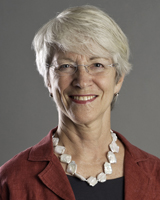From Aspiration to Innovation
 Something must be wrong.
Something must be wrong.
Dr. Barbara Dallap Schaer, Medical Director of New Bolton Center, wanted to schedule an emergency phone call. In my experience, an urgent need to talk to the Dean did not bode well. And when it turned out to be both Dr. Dallap Schaer and New Bolton Center’s Chief of Surgery Dr. Dean Richardson on the line, I almost had a panic attack.
How wrong I was. Drs. Dallap Schaer and Richardson had called to share their excitement about a robotics-driven equine imaging system they had been discussing with a company called Four Dimensional Digital Imaging (4DDI). They envisioned its broad and transformative potential, and their enthusiasm was infectious.
Less than two years later, the robots have arrived at New Bolton Center—poised to revolutionize animal and human health, and positioning Penn Vet at the forefront of a groundbreaking technology. We didn’t just buy this equipment. As the first veterinary teaching hospital in the world using the EQUIMAGINE™ system, Penn Vet is partnering with 4DDI to develop it and advance science in an unprecedented way.
I am exhilarated by the clinical, research, educational, and One Health possibilities of this new system. As a powerful teaching tool, I believe it may transform the way our students learn anatomy. And, we are already exploring translational applications that would tremendously benefit both adults and children. (Learn more here.)
Merriam-Webster defines “innovation” as “a new idea, device, or method” and “the act or process of introducing new ideas, devices, or methods.” The EQUIMAGINE™ system exemplifies innovation in action at Penn Vet. And it is one of many examples of tackling big challenges, forging boldly into new terrain, and introducing out-of-the-box solutions. At Penn Vet, no one ever says, “We don’t do that.” We say, “What if we could do that?”
In our quest to question, improve, and innovate, we often build bridges between disciplines. For instance, in an effort to enhance preparation and precision in veterinary neurosurgery, Dr. Evelyn Galban and her team turned to 3D printing—and established a partnership with PennDesign’s Fabrication Lab (read more here). Like the robotic imaging, 3D printing offers us a new way to see and treat the complex structures of the body.
And, thanks to the generous support of Vernon and Shirley Hill, we are thrilled to launch an innovative and important cross-disciplinary initiative with the Wharton School: the Robert Marshak-Vernon Hill Scholarship Fund, which will support combined VMD-MBA training. There has never been a bigger need for veterinarians with strong business savvy, and for farmers to have veterinary partners to help them address animal, environmental, and economic issues (read more here).
The scholarship fund honors Dr. Robert Marshak, Penn Vet’s ninth Dean, who embodies the School’s tradition of innovation. The Center for Animal Health and Productivity, established under his watch in 1986, continues to serve as an ally to the farming and agriculture industry. As Pennsylvania Department of Agriculture Secretary Russell Redding told Harrisburg’s The Patriot-News this spring, “I can’t imagine being in a state where you do not have access to a veterinary medical school and a campus such as New Bolton and being able to then protect the larger public and animal populations.”
The most recent winners of Penn Vet’s Student Inspiration Award—which was also initiated by the Hills—indicate that innovation continues to flourish here (see here for details). As I think about these ambitious student projects, and about innovation at Penn Vet in general, I can’t help but recall a quote from Dr. Rose Nolen-Walston, Associate Professor of Large Animal Internal Medicine. “I love that you can smell the aspiration in the air!” she said during her interview to work at New Bolton Center. That aspiration—among our students, educators, clinicians, and staff—is what sparks innovation. And if we continue to boldly pursue new discoveries and catalyze new ideas, devices, and methods, we will continue to lead the way.